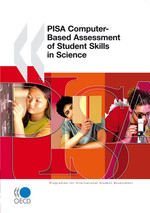Denmark
PISA Computer-based assessment of science
Foreword | Table of contents
How to obtain this publication | Websites
|
ISBN: 9789264082021 |
PISA Computer-Based Assessment of Student Skills in Science This report documents the initial step towards an electronically-delivered Programme for International Student Assessment (PISA) test pioneered by Denmark, Iceland and Korea. In 2006, the PISA assessment of science included for the first time a computer-based test. The results discussed in this report highlight numerous challenges and encourage countries to take the work further. PISA Computer-Based Assessment of Student Skills in Science describes how the 2006 survey was administered, presents 15-year-olds’ achievement scores in science and explains the impact of information communication technologies on both males’ and females’ science skills. While males outperformed females on the computer-based test in all three countries, females in Iceland and males in Denmark performed better than their counterparts on the paper-and-pencil test. The evidence shows that, overall, males are more confident and use computers more frequently. While females tend to use the Internet more for social networking activities, males tend to browse the Internet, play games and download software. Readers will also learn how students reacted to the electronic questionnaire and how it compared with pencil-and-paper tests. In general, there were no group differences across test methods but students enjoyed the computer-based test more than the paper-and-pencil test. |
The capacity of countries – both the world’s most advanced economies as well those experiencing rapid development – to compete in the global knowledge economy increasingly depends on whether they can meet a fast-growing demand for high-level skills. This hinges on significant improvements in the quality of schooling outcomes and a more equitable distribution in learning opportunities.
The OECD’s Programme for International Student Assessment (PISA) makes it possible to regularly and directly compare the quality of educational outcomes across education systems. PISA assesses some of the key competencies contributing to the success of individuals and societies on a regular basis and within an international framework. The results provide a basis for policy dialogue and collaboration in defining and implementing educational goals in innovative ways that reflect judgements about the skills relevant to adult life. Across the globe – whether in Canada in North America, Finland in Europe or Japan and Korea in Asia – countries in PISA show that excellence in education is an attainable goal, and often at reasonable cost. They also show that the challenge of achieving a high and socially equitable distribution of learning outcomes can be successfully addressed and that excellence can be achieved consistently throughout the education systems, with very few students and schools left behind.
- Foreword
- Chapter 1. Introduction
- Chapter 2. Administration of the CBAS Test
- Chapter 3. Students' Achievement in Science
- Chapter 4. Use of Information Communication Technologies (ICT) across Genders and Impact on Achievement
- Chapter 5. CBAS Questionnaire Results
- Chapter 6. Features of the Computer-Based Items and Performance
- Chapter 7. Summary
- References
- Annex A. Sampllng Information
- Annex B. Frequency of Performing ICT Activities by Country and Gender
|
|
How to obtain this publication
Related Documents

